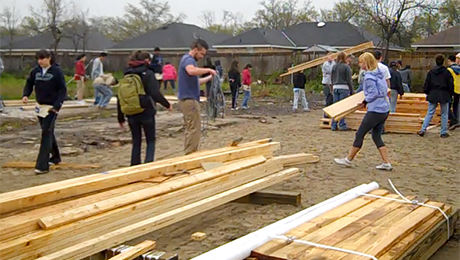By James Irwin
Eleanor Aldous has never been to Ecuador, and when she arrives in the South American country next week it won’t be to spend her spring break on the beaches of Salinas or Puerto Lopez. She will be traveling to Otavalo, an indigenous town located at the base of a sleeping volcano. And she’ll be spending most of her day working on a construction project at a local school.
Ms. Aldous, a senior in the Columbian College of Arts and Sciences, is one of 229 George Washington University volunteers participating in the GW Alternative Breaks program next week. Eleven domestic and international trips will address a series of community issues, including women’s rights, poverty, disaster recovery and education.
The Center for Civic Engagement and Public Service is hosting 17 alternative break trips in 2014 (six others were completed in January over winter break). It’s the largest alternative break effort it has ever hosted in one year, according to executive director Amy Cohen.
Volunteers on the spring service trips are expected to accumulate a total of 8,800 hours of community service. Ms. Aldous, who previously participated in a Winter Alternative Break trip to Honduras, is one of 14 people traveling to Ecuador, the only international location in GW’s spring 2014 program and the first international service trip to be hosted during the spring in at least five years, Ms. Cohen said.
“When I first went to Honduras, what made me fall in love with it was the people,” Ms. Aldous said. “I’m excited to see the differences in how Ecuadorians see the world, what their perspectives are and what they value.”
The Ecuador group will work with the Tandana Foundation, a cross-cultural learning and service organization. The construction project will expand space in the school.
“We’ll be building pillars to support the second story to make room for a principal’s office, storage room and a separate computer lab for the kids,” Ms. Aldous said. “We wanted a hands-on project combined with something culturally oriented, so we could get to know the people but also contribute to a tangible effort.”
The 10 domestic groups will travel to destinations throughout the United States, including Detroit; Tuscaloosa, Ala.; Joplin, Mo.; New Orleans; and New York. A new trip, based in Washington, D.C., will allow participants to stay close to campus and focus on women’s issues of homelessness, hunger, prostitution, sexually transmitted diseases and domestic violence.
The trip to Detroit, also new for 2014, is focusing on urban restoration and community empowerment in a city still recovering from the 2007 economic recession.
“A number of things are taken into account when discussing a new trip, like the need for volunteer service at the destination, the safety of students and the interest of GW students in the location,” said Columbian College senior Mike Cuttler, who serves as operations chair for GW Alternative Breaks. “There are intentionally a wide variety of issues as we seek to engage students from across the GW community in whatever type of service most interests them.”
The Joplin, Tuscaloosa and New Orleans trips are reconstruction and recovery projects. Tornados caused catastrophic damage in Joplin and Tuscaloosa in 2011. The New Orleans trip, the seventh spring trip GW has taken to the city, will assist with the continuing reconstruction of homes for residents affected by Hurricane Katrina.
“We have done more refined work and construction in New Orleans in recent years,” Ms. Cohen said. “In the immediate aftermath of a disaster there is a lot of mucking out of houses and tearing down. It’s sad to say though, even in these locations, we continue to go down and clear out neighborhoods years after the incident. A hurricane lasts a few days but it can take years to rebuild.”


